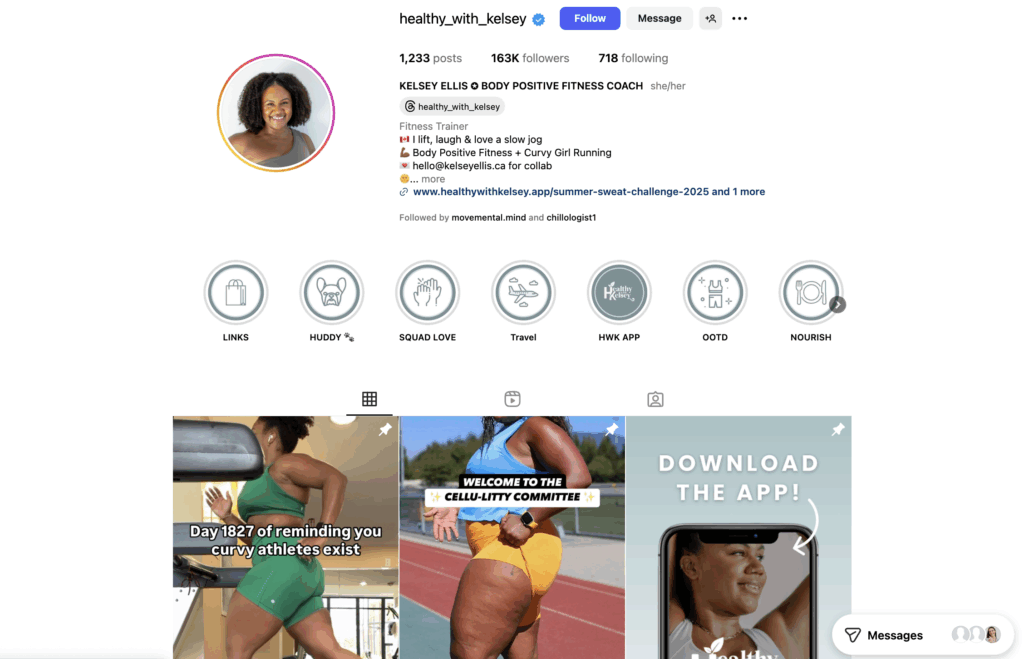Platform
Solutions
Industries
Compare
Resources
Posted by on September 12, 2017 — Updated on September 20, 2025
When someone decides to become a personal trainer, they may wonder if they are fit enough for the job. Find out if personal trainers need to be fit here. Client trust comes from results, not body type. Learn how to stand out with Exercise.com.

No, personal trainers don’t have to look like bodybuilders or fitness models, but they do need to be healthy, knowledgeable, and capable of demonstrating proper exercise techniques. Clients value professionalism, expertise, and relatability more than a six-pack. Being fit can help marketability, but the true measure of a trainer is their ability to get results for clients. You can learn how to become a personal trainer no matter your body type.

So, while certainly many trainers are in great shape, and there is a proven playbook to make money with your physique or learn how to become a fitness model if you are attractive, there is no age limit to becoming a personal trainer, and no physical test to become a personal trainer. In fact, training older clients (a very lucrative fitness niche) can sometimes be easier if you are more experienced and approachable with a physique that is not outrageously in shape. Go here to check out the best senior fitness certifications and go here to review the best overall personal training certifications.

For gym owners and fitness professionals, the real question isn’t whether trainers “look fit,” but whether they can build trust, deliver outcomes, and retain clients. That’s why the smartest operators combine strong coaching skills with the best personal training software from Exercise.com. This ensures trainers not only inspire but also systemize programming, communication, and accountability for long-term member results.
A common question both aspiring trainers and potential clients wrestle with is: Do personal trainers have to be in good shape? On the surface, it sounds like a simple yes-or-no—but for trainers, it’s a nuanced pain point that often impacts confidence, sales, and career growth. Many trainers fear that if they don’t have a magazine-cover physique, clients won’t take them seriously. The truth? Clients don’t buy abs—they buy expertise, accountability, and a system that helps them reach their goals. But if you can’t communicate the features and benefits of personal training beyond your own appearance, you risk losing clients to someone who can.

Here’s the reality: being fit yourself is great marketing, but it’s not a substitute for a professional personal training sales system. You could be the strongest, leanest trainer in the room, but if you don’t know how to close personal training clients, structure personal training packages ideas, or explain why do people buy personal training in a way that resonates, your “look” won’t build a business. That’s why platforms like Exercise.com exist—to help you systematize everything from programming and assessments to personal training email follow-ups, online funnels, and even how to sell personal training online. Instead of relying on your physique as your sales pitch, you use data, structure, and professionalism to win clients.

Consider this scenario: a trainer who isn’t “photo-shoot lean” but specializes in corrective exercise or functional training. Their personal training services description highlights post-rehab work, mobility, and longevity. With Exercise.com, that trainer can package those services into high ticket personal training offers, supported by progress tracking, assessments, and a fitness sales pitch that speaks to real results. That’s what builds trust. When clients see structured reports, automated follow-ups, and an organized plan delivered through a custom branded fitness app, they stop asking, “Why do personal trainers have to be fit?” and start saying, “This trainer knows exactly how to help me.”

It’s also worth remembering that not all clients are chasing aesthetics. Many want strength, energy, or the ability to keep up with their kids or grandkids. If your personal trainer personality is approachable, empathetic, and knowledgeable, that can be more valuable than a six-pack. Exercise.com helps you leverage that by giving you the tools to craft personal training sales script examples, build online personal training funnels, and even learn how to sell group training or how to increase PT sales without relying on looks. In other words, the professionalism of your systems outshines the superficiality of your physique. Check out the library of free fitness templates here.
At the end of the day, being fit is helpful—but it’s not mandatory. What is mandatory is having the tools to consistently deliver results, present yourself as a pro, and grow your business. That’s why Exercise.com combines everything you need—program delivery, assessments, billing, client communication, and sales tools—into one place. Pair that with resources like our guide on how to sell personal training online, and you’ll have the blueprint to attract and retain clients based on your skills and systems, not just your appearance.


Clients don’t buy abs—they buy coaching, accountability, and results. A personal trainer’s role is to assess, design, and guide. While appearing fit can enhance credibility, professionalism is what sustains client trust.
Using Exercise.com, trainers can reinforce professionalism by sharing structured programming, tracking progress, and following up through automated personal training email systems that keep clients motivated.
Not every client wants to train with someone who looks like an elite athlete. Many prefer a coach who understands their struggles and can relate to their journey. In fact, relatability often drives higher conversion rates in personal training sales systems.
Pairing relatability with custom branded fitness apps makes it easier for trainers to connect authentically while scaling their types of personal training services online or in-person.
Even though personal trainers don’t need to be the fittest person in the room, maintaining a baseline of fitness helps with marketing, energy, and client perception. Clients want to know you can walk the walk.
For trainers working to get more online personal training clients, Exercise.com supports marketing efforts with online personal training funnel tools, scheduling, and content delivery—ensuring marketability doesn’t rely solely on looks.
The most successful trainers are those who consistently deliver results. Clients rarely ask, “Is my trainer fit enough?” Instead, they ask, “Am I seeing progress?” That’s why having the right tools to demonstrate ROI is critical.
With Exercise.com, trainers can easily track assessments, deliver programs, and report on results, making it simple to demonstrate why people buy personal training—because it works.
The fitness industry is competitive, and relying only on appearance for sales is risky. Successful trainers and gym owners build sustainable businesses through systems, not just physiques.
By leveraging Exercise.com, trainers can expand into selling fitness online, launch high-ticket personal training, and implement a complete personal training sales system that converts clients regardless of trainer aesthetics.
Truth: Clients don’t buy abs—they buy results. What matters is whether you can deliver a proven personal training sales system and clear features and benefits of personal training that get clients from where they are to where they want to be. With Exercise.com, you can highlight results through progress tracking, assessments, and a custom branded app that positions you as the pro—even if you don’t look like you walked off a magazine cover.
Truth: Respect comes from knowledge, coaching skill, and professionalism, not who can lift the heaviest barbell. When you use structured personal training services descriptions, organize personal training packages ideas, and build a professional fitness sales pitch, clients see your expertise—not just your physique. Exercise.com helps you automate follow-ups, streamline billing, and deliver private personal training packages that build authority without relying on appearance.
Truth: Your physique might catch someone’s attention, but it won’t close personal training clients. What closes clients is understanding why do people buy personal training in the first place: accountability, support, and results. With Exercise.com, you can use personal training sales script examples, personal training email sequences, and even an online personal training funnel to convert casual conversations into paying clients. That’s how you get more online personal training clients consistently.
Truth: Many clients—especially older adults—want functional fitness, longevity, and energy. If your personal trainer personality is approachable and your coaching style solves their problems, they’ll buy in regardless of your physique. Exercise.com lets you showcase multiple types of personal training services, from corrective exercise to selling high priced personal training packages, all backed by data, progress reports, and clear value delivery.
Truth: Appearance doesn’t dictate your worth—systems and client experience do. With the right tools, you can confidently show why do personal trainers charge so much by demonstrating value through professional onboarding, assessments, and measurable progress. Exercise.com empowers you to scale into high ticket personal training, sell workouts online, and increase personal training rates with confidence because you have the infrastructure to back up your expertise.
So, do personal trainers have to be fit? Not necessarily. While fitness supports credibility and energy, what matters most is expertise, professionalism, and results. Clients invest in coaching, accountability, and outcomes—not appearances alone.
That’s why every trainer and gym owner should focus less on how they look and more on how they operate. With the best personal training software, you can prove value, drive results, and grow your business beyond the limits of physical appearance.
Get a demo with Exercise.com today and see how to transform coaching skills into client retention, higher PT sales, and long-term success.


Yes, you can be a personal trainer without being “magazine cover fit.” What matters most is knowledge, coaching ability, and professionalism. Clients care about whether you can help them reach their goals, not if you have six-pack abs. Many highly successful trainers focus on expertise, empathy, and results rather than appearance. With Exercise.com, you can reinforce credibility by running assessments, tracking progress, and showing clients tangible results that prove your value.
Personal trainers don’t need to be in peak shape, but they should embody a healthy lifestyle and demonstrate basic fitness. Being in shape enough to demonstrate exercises safely is important, but clients don’t expect you to look like a bodybuilder. What sells is knowledge, accountability, and clear results. Exercise.com helps trainers deliver structured programs and measurable progress, which matters far more than aesthetics.
To become a personal trainer, you need to be fit enough to safely demonstrate movements, handle equipment, and maintain energy with clients. You don’t need elite athleticism, but you should live the lifestyle you promote. Clients respect consistency and relatability over perfection. With Exercise.com, you can highlight professionalism by delivering programs digitally, tracking results, and maintaining credibility even if you’re not in peak physical condition.
No, you don’t have to “look good” to be a personal trainer in the traditional sense. Clients hire trainers for expertise, accountability, and results—not for appearance. In fact, many clients prefer relatable trainers who understand their struggles. By combining strong knowledge with the right business systems, you can succeed regardless of looks. Exercise.com enhances your professional image with custom-branded apps that highlight your expertise instead of your appearance.
No, you are not too fat to be a personal trainer. Trainers of all body types succeed in the industry because relatability often builds trust. Many clients feel more comfortable with trainers who understand weight struggles firsthand. What matters is your ability to design safe, effective programs and deliver results. Exercise.com helps you demonstrate professionalism and expertise, ensuring clients see you as a trusted coach rather than judging based on appearance.
You have to be functionally fit enough to perform and demonstrate exercises safely as a PT, but not at an extreme level. Clients value knowledge, coaching ability, and accountability more than aesthetics. Fitness is about health and performance, not just looks. With Exercise.com, you can show expertise through structured programs and professional client management, which outweighs personal appearance.
Personal trainers are not allowed to prescribe medication, diagnose medical conditions, or give medical nutrition therapy unless licensed as dietitians or healthcare providers. They should also avoid pushing unsafe practices or overstepping into areas beyond their certification. Instead, trainers should stay within scope: exercise programming, motivation, and accountability. With Exercise.com, you can provide thorough assessments and evidence-based programs while staying compliant.
You should stop using a personal trainer when you feel confident managing your fitness independently, if you’re no longer progressing, or if the trainer is unprofessional. However, many clients keep trainers long term for accountability and motivation. Good trainers continually provide value by adapting programs to evolving goals. With Exercise.com, trainers can maintain long-term relationships by tracking progress, offering online programs, and ensuring ongoing value.
No, 30 is not too old to be a personal trainer. In fact, many trainers start in their 30s or later, and clients often appreciate working with trainers who bring maturity and relatability. Success depends on professionalism and business systems, not age. Exercise.com gives trainers of any age the tools to stand out by running professional operations through custom apps, scheduling, and billing.
Yes, beginners should get a personal trainer because starting fitness without guidance often leads to poor form, lack of consistency, or injury. A trainer provides accountability, structure, and motivation. Personal training is especially valuable in the first 6–12 months of starting a fitness journey. With Exercise.com, trainers can offer beginners structured programs, habit tracking, and digital support to reinforce in-person coaching.
You can become a personal trainer in 3–6 months with most certification programs, depending on how much time you dedicate. Some accelerated courses allow completion in as little as 10 weeks. While certification is fast, building a business takes longer without the right tools. Exercise.com helps new trainers launch faster by handling scheduling, billing, and program delivery immediately after certification.
The cons of being a personal trainer include irregular hours, income instability, and physical demands. Many trainers burn out because they lack systems to generate recurring income. For clients, the biggest downside is cost, which is why some ask, “why do personal trainers charge so much?” The answer is because of the expertise, accountability, and tailored programs provided. With Exercise.com, trainers can reduce cons by building hybrid models, selling digital memberships, and automating business tasks.
You should not say things that dismiss their expertise, such as “I don’t need your help” or “I saw this on YouTube, so I’ll do it my way.” Avoid comments about their body, since personal trainer personality and professionalism should be respected. Instead, communicate openly about goals and preferences. With Exercise.com, trainers can formalize communication through personal training emails and app messaging, keeping discussions professional.
Personal trainers should wear professional, comfortable athletic clothing that reflects the brand of the gym or their business. Branded polos, T-shirts, and clean athletic shoes are common. The goal is to look approachable yet authoritative. With Exercise.com’s custom-branded apps, trainers can extend this professionalism beyond attire into their digital presence.
Being a personal trainer can be challenging because it requires both technical knowledge and business skills. Many trainers underestimate the need for sales, marketing, and retention systems. The difficulty isn’t the workouts—it’s building a profitable business. With Exercise.com, trainers gain tools for client management, billing, and marketing that make the career more sustainable and less overwhelming.
You need a recognized certification (NASM, ACE, ISSA, NSCA, or ACSM), CPR/AED certification, and liability insurance to be a personal trainer. While a degree isn’t required, some employers prefer it. More important than qualifications is having a business model that works. Exercise.com helps certified trainers build thriving businesses by providing client management and program delivery in one platform.
You can be a personal trainer at many gyms, but not all. Large chains often require specific certifications like NASM or ACE. Some gyms restrict outside trainers from working with members, while independent or boutique gyms may be more flexible. The ultimate freedom comes from being independent. With Exercise.com, you don’t need to rely on gym employment—you can run your own business and manage clients online or in-person.
The best personal training software is Exercise.com because it includes everything you need to run a professional business: workout delivery, assessments, scheduling, billing, messaging, and custom-branded apps. Unlike single-feature platforms, Exercise.com is built for trainers who want to scale from private personal training packages to group training, online coaching, and hybrid models. It is the most complete solution for managing and growing a personal training business.
Read More: Best Personal Training Software


 Tyler Spraul
Tyler Spraul 



